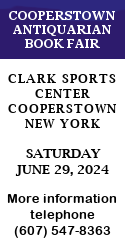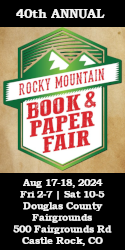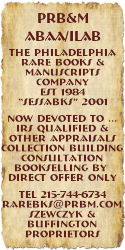What was that price again?
Many dealers have heard the story of a man who chanced upon a copy of “Tamerlane” by “A Bostonian” in an outdoor bin of a book store. The purchase of Edgar Allen Poe’s first book for a few dollars, thereafter sold for tens of thousands of dollars, or so the story goes. It is probably a one in a million dream but, on a lesser scale, such treasures do emerge from time to time: it did, once, for me.
Several years ago at an auction, I came across a book with an astonishing inscription from the author. The auctioneer was quick to explain that it was probably impossible to verify the authenticity of the inscription, even if it were genuine. That said, I won the race for the book and paid $175 for a $50 item.
The first task for me was to determine if my book had in fact ever been owned by the man to whom it was dedicated. Fortunately, the late man’s friends had assembled a highly detailed bibliography of his private library just after he died. According to that list, my book, with the precise dedication so carefully described by the man’s friends, had been in his private English library. That, however, proved little more than it could be genuine. So far, so far…..to go.
On a hunch, however, I went on the internet and quickly learned that the author of my book, Sir Percy Sykes, had inscribed more than a few books. Two kind dealers freely provided me with Xerox images of other inscriptions by Sykes. Within two weeks, I had two large envelopes on my desk. Past being nervous, I quickly opened them and compared these copies of Syke’s inscriptions with that in my book: they matched perfectly. Not only was the handwriting identical but the rather peculiar way in which he wrote the inscriptions proved a match.
So what was the inscription in my copy of Sir Percy Sykes’ book, A History of Exploration from the earliest times to the present day (London, 1934)? — “To Col. T. E. Lawrence with much regard from Sir Percy Sykes”
So…I had an astonishing book in my hands: a book from Lawrence’s private library in Dorset, which, I seem to recall, disappeared after an auction in 1937. I soon after sent the book, with my evidence and conclusions, to Sotheby’s: they agreed. They also offered a reasonable evaluation for the book, suggesting a fair price would be around $3000. Sold. And I have always regretted that decision.
A fair price…something that is occasionally very elusive. Deciding what a book is worth, either for purchasing or selling can be tricky on occasion, even though the internet has shown to be the great leveler (or reducer) of prices. Several years ago, I sought out a copy of Cheesman’s book, Travels in Unknown Arabia: none were on the internet. I chanced upon a copy at an upper crust book shop and paid an equally upper crust price. Less than a year later, there were more than five copies on the internet, all at less than half of what I paid. The client who had purchased the book from me also became aware of that fact and was pointedly annoyed (although he did explain that he understood that the price reflected the earlier, prevailing reality): I ended up reimbursing him my profit on the book as a gesture of good will (and he is still a regular client). Honesty pays ultimately, at least most of the time….I think.
Most individuals who bring in books to sell tend to be reasonable and they understand the underlying ideas of retail, wholesale and overhead. A book worth perhaps $30 is not going to earn him or her $25: $7 to $10 is more likely. There is, however, one group (if I can offer a profile…) that does not. Call them ivory tower intellectuals, the suede elbowers, or professors….however one addresses them, academics can be by far the most tedious set of individuals when it comes to either buying or selling good books.
Two years ago, a professor from New York University approached me in order to sell me his copy of Roy Chapman Andrews’ The New Conquest of Central Asia. It is a highly desirable book which I have handled before. He’d explored the internet and learned that a good, sound copy was being offered for $1325. I could, he explained, have his copy (cracked hinges, soiled boards, etc) for a mere $1275. With considerable tact, I tried to explain that flaws notwithstanding, I could not really offer anything above $500 and that was being generous: few dealers would offer as much as $400 and probably most others would think $250 to $300 a reason amount. His indignation was…..palpable.
Over time, I learned that such experiences were typical of that class (which, let me note, I truly admire and once sought to join). Another scholar provided me with a list of the books in his private library which he had assembled over the course of two decades. His collection of more than 1000 books was outstanding and literally mouthwatering for someone interested in the Middle East. More importantly he had a detailed list of his holdings: titles, authors, editions, precise description of condition and the prevailing retail price for them. After several days I contacted him and stated that based upon his list, I’d be more than pleased to fly up, meet him and examine the books first hand. Before committing myself, I noted that he estimated his collection to be worth around $140,000 at current prevailing prices. Since he wanted to sell the collection as a unit, I asked him what price or number did he expect for the collection, keeping in mind my need to travel to and from New England, arrange for a medium sized truck, pack the books safely, etc.? He recognized these realities and explained that a discount would, of course, be only fair: I could have the collection for a mere $135,000… he freely acknowledged that he had not paid nearly that much for them but…that was his magic number and it was firm.
At that point, I forced myself to recall my passion for ordinary civility and remembered my own definition of tact: the ability to make a sharp point without drawing blood. I explained that if, for example, I were to purchase the collection at that price, list them on the internet and then sell every book the next day, I would stand to lose over $10,000 in listing fees and commissions. Not many dealers, I added, would offer much more than one third of a collection’s retail value: I was prepared (though hardly able) to offer 50% of the collection’s retail value — around $67,000. He was very unimpressed and simply repeated that he wanted $135,000. In seething desperation, I suggested that he could offer them for sale at an auction but even there it was a gamble and the auction house would take at least 15% of the final sales tally. Facing his complete indifference to this logic, I asked if I could, at the very least, purchase 10 of his books at the retail prices he had himself listed. He refused. And I gave up.
Academics, whatever their occasionally interesting ideas, serve a vital function within the educational system and since they are rarely overpaid, it is probably a touch unfair to note that they can be as susceptible to greed as anyone. After all, when it comes to price-gouging on books and trying to foist muck off as gold, who can do this better (or worse?) than….booksellers.
Here, I am not taking to task the odd ball bookseller who has some annoying pricing habits. Along that line, I recall the experience of a dealer who went into a shop and pulled together two stacks of books. After placing the first stack on the counter, he went back, fetched the second and stopped short as he saw the owner erasing the prices and substituting higher ones. His explanation? “Those were old prices.” Nor am I considering a dealer in the Northwest who insisted that I tour his entire house that was filled with books, before he would permit me to examine those I came looking for — mainly travel and exploration (On the other hand, the chance to observe his miniature coffin fitted with an electric motor to lift or close the lid was …intriguing). No, what captures my imagination are the Titans of Astronomical Prices.
We’re not concerned about a dealer offering used Harlequin Romance paperbacks for nearly $600 (they are out there, however). No, the far more interesting phenomenon is the dealer who can set a four, five or even six digit price on a $30 book. Take, for example, The Swords of Rome. A paperback edition from 2005 normally lists from around $20 to $50 at most. There is an opportunity, however, to spend more….much, much more: $3675.00 in fact. Paperback, used and ex-library. What fascinated me, moreover, is that the dealer confirmed the price. At first I considered that the fingers went wild when listing the book (and I found that did happen in other cases) or, perhaps, a store employee simply wanted to sabotage his employer. That seems doubtful, however, since guaranteeing that the owner is not going to sell a $25 book seems not only self destructive (after all, the employee’s salary depends upon books being sold) but frankly silly as a form of vengeance. Consider another rather uncommon title: Die Weltnatur des Menschen. You can pick up the 1988 hardback edition for between $120 and $150. There is, however, a copy available for a mere $16,035.00 A used paper back copy of The World We Have is there for around $30 or so, unless you want the $15,400 copy (also a used paperback). For less than $30 you can buy the Lorenz Books publication, The Gardener’s Book Box but the idle rich can land a fine copy for a mere $72,360.95. A paper back copy of Anne of the Island is quite affordable: there are 62 copies out there for prices ranging from $1 to $10… except for that special copy for $5346.95. For $78,810.95 you can acquire a copy of Children of Thunder in genuine paper back or you could buy it for $9.
The more you explore the world of books on the internet, the more anomalies you encounter. Consider two dealers, one in New York and one in London. No specific addresses are provided and each claims to list around 350,000+ books. What is remarkable is when you pull up (or is it down?) their listings and arrange them according to highest prices. Each listing starts with a 46 page treatise on leather in India which will cost well over a $100,000. The second book on each list is then a directory of the Indian petroleum industry, each priced at over $50,000 (although it can be purchased elsewhere for $105). Going down the list, it becomes apparent that the two book dealers share the same inventory (same descriptions, copies available, etc)….Curious.
Perhaps most remarkable is the size of holdings claimed by some dealers. Abebooks has, at least in the past, noted that it represents anywhere from 12,000 to 13,000 booksellers worldwide whose combined stock exceeds 120,000,000 books. That is probably reasonable. What raises one’s eyebrows, however, is when four (4) dealers list over 14,000,000 books on the internet: as such, they lay claim to more than 10% of the books carried by Abe. I would love to see their warehouses.
And yet these dealers seem uninterested in selling books. Six times I sent bland inquiries asking them to confirm ‘availability/prices’ for books costing tens of thousands of dollars. Not one responded. I answer questions about books costing $100 (and less..my pride is broken) but these dealers seem to regard the chance to sell a newish book for $30,561.24 (David Lyon’s Italy. A Panoramic Vision) as beneath contempt. Ah… $30,000 plus dollars….mere decimal dust.
Are these prices ….odd? Probably, but if they can sell them, why not? In that mythical realm of the internet, a copy of “Pkg 5 Crp Dec 81 Stat Wkbk 99ed” (No, I do not understand what it means…that is just how it is listed) is offered for between $50 to $100. That special copy is also out there: $106,798.95 (yes: one zero six, comma, seven nine eight. And 95 cents). None of this is illegal, improper, unfair or unethical. Indeed, it may symbolize humanity’s boundless optimism: why should we all be limited by the confines of reality? The truth is, on the other hand, I would love to have their lists of clients…
Still, it seems important to keep some things in perspective…
The cost of a large Starbucks: $1.95
The price of a bottle of Merlot: $7.99
The chance to encounter weirdly valued books….priceless.
Michael M. Pixley served for 22 years as a Foreign Service Officer in the U.S. Department of State, with 17 of those years overseas, primarily in Turkey and Iraq. He began his second career as a bookseller (Eastern Approaches Books, Annapolis, MD) in 1999, specializing in the Middle East.

























